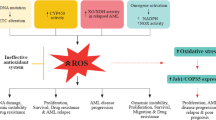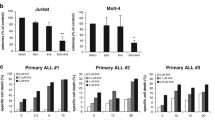Abstract
We investigated the in vitro efficacy of all-trans retinoic acid (ATRA) and alpha-tocopherol succinate (α-TS) alone and in combination on the induction of cell death in freshly isolated leukemic cells obtained from chronic myeloid leukemia (CML) patients. In vitro cytotoxicity and induction of lipid peroxidation by ATRA (10 μM) and α-TS (25 or 50 μM) were evaluated in primary leukemic cells by MTT [3-(4,5-dimethylthiazol-2-yl)-2,5-diphenyltetrazolium bromide] assay and malondialdehyde formation respectively. Treatment of leukemic cells with α-TS alone or in combination with ATRA significantly (P < 0.05) decreased the cell viability in a concentration and time dependent manner as compared to peripheral blood mononuclear cells obtained from normal healthy controls. Lipid peroxidation was enhanced by 98% (P < 0.05) on combined treatment of cells with ATRA (10 μM) and α-TS (50 μM). ATRA alone did not enhance the externalization of phosphatidyl serine as studied by annexin-V binding using fluorescence activated cell sorter analysis, whereas in combination with α-TS it increased to 400% at 12 h. The treatment of leukemic cells to combination of ATRA with α-TS significantly decreased (P < 0.05) mitochondrial membrane potential and enhanced lysosomal destabilization. The combination of these drugs also increased mitochondrial and cytosolic reactive oxygen species (ROS) production, nitric oxide levels, and caspase-3 activity significantly and caused DNA fragmentation at 24 h in a concentration dependent manner in the leukemic cells. Our data suggest that ATRA in combination with α-TS efficiently induces apoptosis in leukemic cells, which may be a useful therapeutic modality in CML patients.






Similar content being viewed by others
References
Martin SJ, Green DR (1995) Apoptosis and cancer: the failure of controls on cell death and cell survival. Crit Rev Oncol Hematol 18:137–153
Fisher DE (1994) Apoptosis in cancer therapy: crossing the threshold. Cell 78:539–542
Mencher SK, Wang LG (2005) Promiscuous drugs compared to selective drugs (promiscuity can be a virtue). BMC Clin Pharmacol 5:3
Nilsson B, Olofsson T, Olsson I (1984) Myeloid differentiation in liquid cultures of cells from patients with chronic myeloid leukemia: effects of retinoic acid and indomethacin. Exp Hematol 12:91–99
Russo D, Regazzi M, Sacchi S, Visani G, Lazzarino M, Avvisati G, Pelicci PG, Dastoli G, Grandi C, Iancona I, Candoni A, Grattoni R, Galieni P, Rupoli S, Liberati AM, Maiolo AT (1998) All-trans retinoic acid (ATRA) in patients with chronic myeloid leukemia in the chronic phase. Leukemia 12:449–454
Marley SB, Davidson RJ, Goldman JM, Gordon MY (2002) Effects of combinations of therapeutic agents on the proliferation of progenitor cells in chronic myeloid leukemia. Br J Haematol 116:162–165
Dutcher JP, Lee S, Gallagher RE, Makary AZ, Hines JD, Londer H, Farnen JP, Bennett JM, Paietta E, Rowe JM, Goloubeva O, Wiernik PH (2005) Phase II study of all-trans retinoic acid in the accelerated phase or early blastic phase of chronic myeloid leukemia: a study of the Eastern Cooperative Oncology Group (E1993). Leuk Lymphoma 46:377–385
Burton GW, Traber MG (1990) Vitamin E: antioxidant activity, biokinetics, and bioavailability. Annu Rev Nutr 10:357–382
Zhao Y, Zhao X, Yang B, Neuzil J, Wu K (2007) Alpha-Tocopheryl succinate-induced apoptosis in human gastric cancer cells is modulated by ERK1/2 and c-Jun N-terminal kinase in a biphasic manner. Cancer Lett 247:345–352
Malafa MP, Fokum FD, Andoh J, Neitzel LT, Bandyopadhyay S, Zhan R, Iiizumi M, Furuta E, Horvath E, Watabe K (2006) Vitamin E succinate suppresses prostate tumor growth by inducing apoptosis. Int J Cancer 118:2441–2447
Wang XF, Dong L, Zhao Y, Tomasetti M, Wu K, Neuzil J (2006) Vitamin E analogues as anticancer agents: lessons from studies with alpha-tocopheryl succinate. Mol Nutr Food Res 50:675–685
Swettenham E, Witting PK, Salvatore BA, Neuzil J (2005) Alpha-tocopheryl succinate selectively induces apoptosis in neuroblastoma cells: potential therapy of malignancies of the nervous system? J Neurochem 94:1448–1456
Kline K, Yu W, Sanders BG (2001) Vitamin E: mechanisms of action as tumor cell growth inhibitors. J Nutr 131:161S–163S
Barnett KT, Fokum FD, Malafa MP (2002) Vitamin E succinate inhibits colon cancer liver metastases. J Surg Res 106:292–298
Malafa MP, Neitzel LT (2000) Vitamin E succinate promotes breast cancer tumor dormancy. J Surg Res 93:163–170
Heeg K, Reimann J, Kabelitz D, Hardt C, Wagner H (1985) A rapid colorimetric assay for the determination of IL-2-producing helper T cell frequencies. J Immunol Methods 77:237–246
Neuzil J, Weber T, Schroder A, Lu M, Ostermann G, Gellert N, Mayne GC, Olejnicka B, Negre-Salvayre A, Sticha M, Coffey RJ, Weber C (2001) Induction of cancer cell apoptosis by alpha-tocopheryl succinate: molecular pathways and structural requirements. FASEB J 15:403–415
Zang Y, Beard RL, Chandraratna RA, Kang JX (2001) Evidence of a lysosomal pathway for apoptosis induced by the synthetic retinoid CD437 in human leukemia HL-60 cells. Cell Death Differ 8:477–485
Shi GY, Gao F, Shi XG, Tang XM (2001) Detection of cellular reactive oxygen species by flow cytometry. Shanghai Di-er Yike Daxue Xuebao 21:122–124
Green LC, Wanger DA, Glogowski J, Skipper PL, Wishnok JS, Tannenbaum SR (1982) Analysis of nitrate, nitrite, and (15N) nitrate in biological fluids. Anal Biochem 126:131–138
Salvioli S, Ardizzoni A, Franceschi C, Cossarizza A (1997) JC-1, but not DiOC6(3) or rhodamine 123, is a reliable fluorescent probe to assess delta psi changes in intact cells: implications for studies on mitochondrial functionality during apoptosis. FEBS Lett 411:77–82
Ohkawa H, Ohishi N, Yagi K (1979) Assay for lipid peroxides in animal tissues by thiobarbituric acid reaction. Anal Biochem 95:351–358
Zhang X, Lin H, Chen C, Chen BD (1999) Inhibition of ubiquitin-proteasome pathway activates a caspase-3-like protease and induces Bcl-2 cleavage in human M-07e leukaemic cells. Biochem J 340:127–133
Gorczyca W, Bigman K, Mittelman A, Ahmed T, Gong J, Melamed MR, Darzynkiewicz Z (1993) Induction of DNA strand breaks associated with apoptosis during treatment of leukemias. Leukemia 7:659–670
Martin SJ, Reutelingsperger CP, McGahon AJ, Rader JA, van Schie RC, LaFace DM, Green DR (1995) Early redistribution of plasma membrane phosphatidyl serine is a general feature of apoptosis regardless of initiating stimulus: inhibition by overexpression of Bcl-2 and Abl. J Exp Med 182:1545–1556
Verhoven B, Schlegal RA, Williamson P (1992) Rapid loss and restoration of lipid asymmetry by different pathways in resealed erythrocyte ghosts. Biochem Biophys Acta 1104:15–23
Foghsgaard L, Lademann U, Wissing D, Poulsen B, Jaattela M (2002) Cathepsin B mediates tumor necrosis factor-induced arachidonic acid release in tumor cells. J Biol Chem 277:39499–39506
Jain SK, Mohandas N, Clark MR, Shohet SB (1983) The effect of malonyldialdehyde, a product of lipid peroxidation, on the deformability, dehydration and 51Cr-survival of erythrocytes. Br J Haematol 53:247–255
Jain SK (1984) The accumulation of malonyldialdehyde, a product of fatty acid peroxidation, can disturb aminophospholipid organization in the membrane bilayer of human erythrocytes. J Biol Chem 259:3391–3394
Jain SK (1985) In vivo externalization of phosphatidylserine and phosphatidylethanolamine in the membrane bilayer and hypercoagulability by the lipid peroxidation of erythrocytes in rats. J Clin Invest 76:281–286
Nicholls DG, Ferguson SJ (1992) Bioenergetics 2. Academic Press, London
Schmidt-Mende J, Gogvadze V, Hellstrom-Lindberg E, Zhivotovsky B (2006) Early mitochondrial alterations in ATRA-induced cell Death. Cell Death Differ 13:119–128
Newcomer ME (1995) Retinoid-binding proteins: structural determinants important for function. FASEB J 9:229–239
Armstrong JL, Ruiz M, Boddy AV, Redfern CP, Pearson AD, Veal GJ (2005) Increasing the intracellular availability of all-trans retinoic acid in neuroblastoma cells. Br J Cancer 92:696 –604
Dussmann H, Kogel D, Rehm M, Prehn JH (2003) Mitochondrial membrane permeabilization and superoxide production during apoptosis. A single-cell analysis. J Biol Chem 278:12645–12649
Weber T, Dalen H, Andera L, Negre-Salvayre A, Auge N, Sticha M, Lloret A, Terman A, Witting PK, Higuchi M, Plasilova M, Zivny J, Gellert N, Weber C, Neuzil J (2003) Mitochondria play a central role in apoptosis induced by a-tocopheryl succinate, an agent with anticancer activity: comparison with receptor mediated pro-apoptotic signaling. Biochemistry 42:4277–4291
Alleva R, Tomasetti M, Andera L, Gellert N, Borghi B, Weber C, Murphy MP, Neuzil J (2001) Coenzyme Q blocks biochemical but not receptor mediated apoptosis by increasing mitochondrial antioxidant protection. FEBS Lett 503:46–50
Kogure K, Morita M, Nakashima S, Hama S, Tokumura A, Fukuzawa K (2001) Superoxide is responsible for apoptosis in rat vascular smooth muscle cells induced by a-tocopheryl hemisuccinate. Biochim Biophys Acta 1528:25–30
Neuzil J, Zhao M, Ostermann G, Sticha M, Gellert N, Weber C, Eaton JW, Brunk UT (2002) Alpha-tocopheryl succinate, an agent with in vivo anti-tumour activity, induces apoptosis by causing lysosomal instability. Biochem J 362:709–715
Khanduja KL, Avti PK, Kumar S, Pathania V, Pathak CM (2005) Inhibitory effect of vitamin E on proinflammatory cytokines-and endotoxin-induced nitric oxide release in alveolar macrophages. Life Sci 76:2669–2680
Kolb JP (2000) Mechanisms involved in the pro- and anti-apoptotic role of NO in human leukemia. Leukemia 14:1685–1694
Wallace DC (1999) Mitochondrial diseases in man and mouse. Science 283:1482–1488
Baran CP, Zeigler MM, Tridandapani S, Marsh CB (2004) The role of ROS and RNS in regulating life and death of blood monocytes. Curr Pharm Des 10:855–866
Boveris A, Alvarez S, Navarro A (2002) The role of mitochondrial nitric oxide synthase in inflammation and septic shock. Free Radic Biol Med 33:1186–1193
Nishikawa M, Sato EI, Utsumik K, Inoue M (1996) Oxygen dependent regulation of energy metabolism in ascites tumor cells by nitric oxide. Can Res 56:4535–4540
Giulivi C (2003) Characterization and function of mitochondrial nitric-oxide synthase. Free Radic Biol Med 34:397–408
Wu K, Zhao L, Li Y, Shan YJ, Wu LJ (2004) Effects of vitamin E succinate on the expression of Fas and PCNA proteins in human gastric carcinoma cells and its clinical significance. World J Gastroenterol 10:945–949
Ushmorov A, Ratter F, Lehmann V, Droge W, Schirrmacher V, Umansky V (1999) Nitric oxide-induced apoptosis in human leukemic lines requires mitochondrial lipid degradation and cytochrome C release. Blood 93:2342–2352
Author information
Authors and Affiliations
Corresponding author
Rights and permissions
About this article
Cite this article
Kumar, S., Khanduja, K.L., Verma, N. et al. ATRA promotes alpha tocopherol succinate-induced apoptosis in freshly isolated leukemic cells from chronic myeloid leukemic patients. Mol Cell Biochem 307, 109–119 (2008). https://doi.org/10.1007/s11010-007-9590-7
Received:
Accepted:
Published:
Issue Date:
DOI: https://doi.org/10.1007/s11010-007-9590-7




